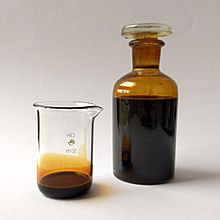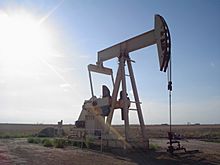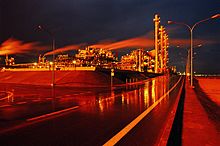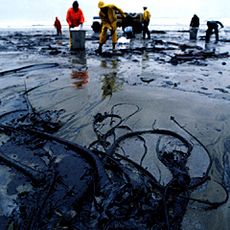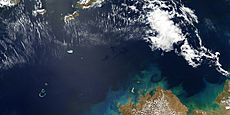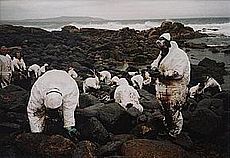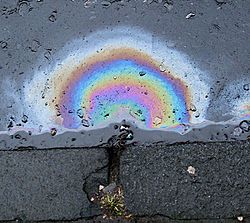Petroleum facts for kids
Petroleum, also known as crude oil, is a thick, black liquid found deep underground. The word "petroleum" comes from Greek words meaning "rock oil." It's a natural material mostly made of hydrocarbons, which are chemicals that burn easily.
Most petroleum is found by drilling into rocks on land or under the sea, near the coast. Big producers of oil are in the Middle East, the Americas, and Russia. Petroleum is super important because it provides a lot of the world's energy, about 38% of it! It's also used to make many other useful chemicals called petrochemicals.
Crude oil is a mix of many different chemicals. In special factories called oil refineries, it's heated and separated into simpler, more useful parts. These parts include gasoline (or petrol) for cars, kerosene for airplanes, and bitumen for roads. Bitumen is what gives crude oil its dark black color. Most of the other chemicals in crude oil are light yellow or clear.
Petroleum can be moved easily through long pipes called pipelines. Once it's processed, petroleum becomes different kinds of fuels. These include gasoline for cars, diesel fuel for trucks, trains, and ships, and kerosene for jet planes. It's also used to make lubricants, which are oils and greases that help machines run smoothly.
Contents
How Did Petroleum Form?
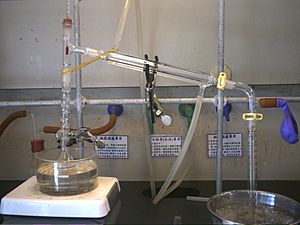
Millions of years ago, tiny plants and animals lived in the oceans. These included Phytoplankton (tiny plants) and zooplankton (tiny animals). When these organisms died, their remains sank to the bottom of the sea.
Over time, layers of mud and sand piled up on top of these remains. This created huge pressure, like squeezing a sponge. These layers buried the dead organisms in places where there was very little or no oxygen. This stopped them from rotting away completely.
For millions of years, the increasing pressure and heat deep inside the Earth changed the buried organic matter. The huge pressure squeezed out water and gases, leaving behind a thick, oily substance. This substance is petroleum!
Petroleum is lighter than water, so it often moves upwards through rocks that have tiny holes (porous rocks). It keeps moving until it gets stuck under a layer of rock that oil can't pass through. This is like water collecting in a sponge, but it's oil trapped underground.
Today, people use special tools and methods to find and get petroleum from these underground storage areas, called reservoirs. We drill deep wells into the Earth to reach these reservoirs and bring the oil to the surface.
What Is Petroleum Used For?
Petroleum is super useful! It's not just the gasoline that fuels cars. It's used to make thousands of products we use every single day.
- Gasoline and diesel fuel: This is one of the most common uses. Petroleum is processed to separate its different parts. Gasoline powers cars and airplanes, while diesel fuel powers trucks, buses, and ships.
- Plastics: Many plastics are made from petroleum. Think about your toys, water bottles, and even your phone case!
- Asphalt: This is the sticky, black material used to make roads and pavements. Every time you drive on a road, you're driving on something made from petroleum.
- Lubricants: Petroleum is used to make oils and greases that help machines run smoothly without grinding.
- Medications: Some medicines and medical tools are made using products that come from petroleum.
- Synthetic fabrics: Some man-made fabrics, like nylon, are created from petroleum.
- Fertilizers: Petroleum is used to help make fertilizers. These help our crops grow bigger and healthier.
- Cosmetics: Some makeup and beauty products contain ingredients that come from petroleum.
History of Petroleum Use
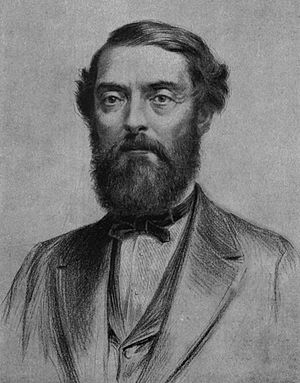
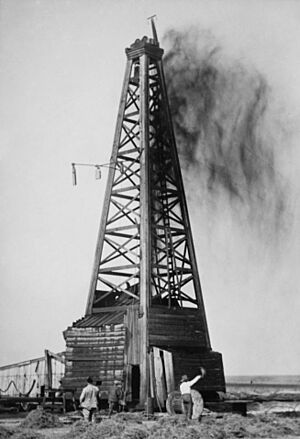
People have used petroleum in different ways for thousands of years. More than 4300 years ago, the Sumerians used bitumen (a thick form of petroleum) to build boats. Over 4000 years ago, people in Babylon used asphalt to build walls and towers.
In ancient China, people used oil more than 2000 years ago. By the year 347 CE, they were drilling for oil using bamboo poles!
In the 7th century, petroleum was a key part of Greek fire. This was a fiery weapon used by the Byzantine Greeks against enemy ships. Persian chemists also learned how to refine crude oil. The streets of Baghdad were even paved with tar that came from natural oil fields nearby.
The world's first oil refinery was built in 1856 by Ignacy Łukasiewicz in Austria.
The need for petroleum as a fuel for lighting quickly grew, especially in North America.
The first oil well in the Americas was drilled in 1859 by Edwin Drake in Pennsylvania. This started a big boom in oil drilling.
In the early 1900s, oil exploration in North America made the U.S. the top oil producer by the middle of the century. However, as U.S. oil production reached its highest point in the 1960s, Saudi Arabia and the Soviet Union started producing more oil.
As of 2018, the top three oil-producing countries are the United States, Russia, and Saudi Arabia. In 2018, thanks to new methods like hydraulic fracturing and horizontal drilling, the United States became the world's largest producer again.
About 80% of the world's easily reachable oil reserves are in the Middle East. About 62.5% of these come from five Arab countries: Saudi Arabia, United Arab Emirates, Iraq, Qatar, and Kuwait.
Petroleum and Numbers
The numbers related to petroleum are huge! Millions of barrels of petroleum are produced and used around the world every single day. (A barrel is about 159 liters).
- Global production: The amount of petroleum produced worldwide changes each year. This depends on what the market needs and how much technology has improved for getting oil. In recent years, about 80 to 100 million barrels are produced daily.
- Global consumption: The amount of oil used worldwide is similar to how much is produced. It changes based on how the economy is doing and how much energy people need. Millions of people use products made from petroleum every day.
- Reserves: Geologists are always looking for and estimating how much petroleum is left in the Earth. These numbers are updated often, but it's believed that trillions of barrels of petroleum are still in reserves.
- Price changes: The price of petroleum is affected by many things. These include how much oil is available and how much people want it, big world events, and how strong different countries' economies are. You often hear about oil prices in the news because they are very important to the global economy.
Environmental Effects of Petroleum
As of 2018, about a quarter of the yearly global greenhouse gas emissions comes from burning petroleum. This includes carbon dioxide and methane leaks from the oil industry. Burning petroleum, along with burning coal, is the biggest reason for the increase in carbon dioxide in our atmosphere.
Ocean acidification happens when the Earth's oceans become more acidic. This is caused by the oceans absorbing too much carbon dioxide from the air. This increased acidity harms all sea life, especially smaller organisms and those with shells.
Crude oil and refined fuel spills from tanker ship accidents have damaged natural places and people's ways of life. This has happened in Alaska, the Gulf of Mexico, the Galápagos Islands, France, and many other places. Oil spills at sea are usually much more harmful than spills on land. This is because oil can spread for hundreds of miles in a thin layer, covering beaches with oil. This can kill sea birds, mammals, shellfish, and other creatures it covers. Oil spills on land are easier to control if a dirt wall can be quickly built around the spill before most of the oil escapes. Land animals can also avoid the oil more easily.
Alternatives to Petroleum
In 2018, road transport used 49% of petroleum, and aviation used 8%. Other uses that were not for energy took up 17%. Electric vehicles are the main alternative for cars and trucks. For airplanes, biojet fuel is an alternative. Single-use plastics, which are made from petroleum, create a lot of carbon pollution and can harm the ocean. However, as of 2022, the best alternatives for these plastics are still being explored.
Images for kids
-
Octane, a hydrocarbon found in petroleum. Lines show single bonds; black circles are carbon; white circles are hydrogen.
-
Some types of crude oil with their sulfur content and density, plus how much is produced.
-
Shale bings (piles of waste rock) near Broxburn, Scotland. There are 3 shown here out of 19 in West Lothian.
-
This old poster from World War II encouraged carpooling to save gasoline.
-
A gas station in Brazil selling four different alternative fuels: diesel, gasohol, neat ethanol, and compressed natural gas (CNG).
See also
 In Spanish: Petróleo para niños
In Spanish: Petróleo para niños


